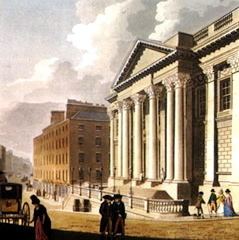Name Thomas Cooley Role Architect | Died 1784 | |
 | ||
Similar People James Gandon, William Chambers, James Hoban | ||
Henry purcell music for a while thomas cooley with voices of music
Thomas Cooley (1740–1784) was an English-born Irish architect who came to Dublin from London after winning a competition for the design of Dublin's Royal Exchange in 1768.
Contents
- Henry purcell music for a while thomas cooley with voices of music
- Henry purcell oh fair cedaria thomas cooley with voices of music
- Early years
- Architecture career and Ireland
- List of buildings designed or built by Cooley
- Personal
- References
Henry purcell oh fair cedaria thomas cooley with voices of music
Early years
Cooley was born to William and Mary Cooley in London and began his career as a carpenter apprenticeship in 1756 with interest in architecture.
Cooley worked as a draughtsman and clerk to the architect and engineer Robert Mylne (1733–1810), while the latter was building Blackfriars Bridge in London, between 1761 and 1769. In 1769, he won the competition to design a new Royal Exchange in Dublin, and the building, now the City Hall, was completed in 1779. The design shows the influence of Mylne's work, which in turn derived from French neoclassical architecture.
Architecture career and Ireland
Arriving in Ireland in 1781, Cooley built several public buildings in Dublin in the neoclassical style. Together with James Gandon (1743–1823), Cooley was part of a small school of architects influenced by Sir William Chambers (1723–1796).
Cooley also designed Newgate Prison (demolished 1893), the Marine School, and a chapel, all in Dublin. In 1781 he began another public building in the city, but on his death at the age of 44 in Dublin, the project was handed over to Gandon, who completed it, to his own design, as the Four Courts.
Outside Dublin, Cooley built a number of country houses including Caledon (1779), for James Alexander, later Earl of Caledon. He designed several buildings in Armagh, including the Archbishop's Palace (now the town hall), and the public library.
List of buildings designed or built by Cooley
This is an incomplete list of buildings from Cooley:
Personal
From 1781 Cooley remained in Ireland until the end of his life. He was survived by a son William and a daughter and was predeceased by his wife.
